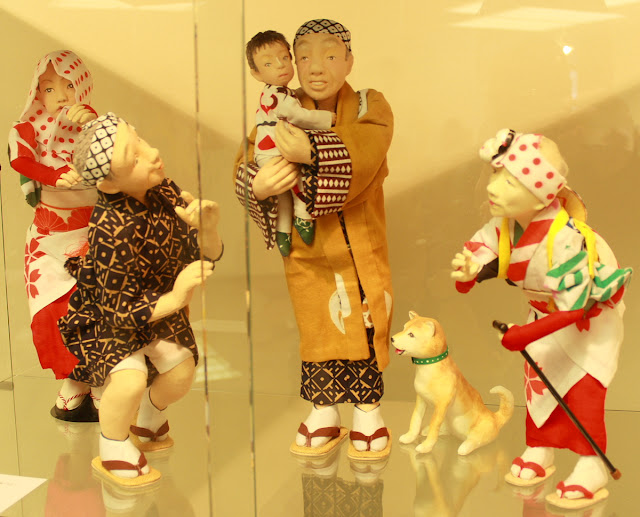Once a year , they organize a Japan Day with market and events and in the evening a fireworks display.
The Eko House in Duesseldorf, where I'd visited the Japanese garden last year , holds a special open door event during the Japan Day : a unique opportunity to visit the buddhist Temple and their Japanese Wooden House.
I was frankly amazed at how richly decorated the Buddhist temple was.
Above the two paintings of peacocks on each side of the main altar, were very detailed gilded ( gold foil plated ) wood carvings displaying scenes with peacocks.
The panel on the left :
and the woodcarving above it :
The panel on the right :
and the woodcarving above it :
the beautiful wood patterns of the ceiling plates ,
the copiously decorated gilded lanterns ,
and the altar itself , decorated with fresh flower bouquets.
It was dark in there : I used 2 seconds of exposure time ( from such a distance a flash is useless ).
Underneath the main hall was a display of beautifully crafted unique japanese puppets with the theme "Watching the fireworks".
Older people watching the fireworks above them ,
and younger ones.
The Eko House also has a wooden Japanese house in the back , that was open for visitors.
View along the hallway :
I have taken all the pictures below , while sitting in seiza position, so the views are the same as you would get , when living and sitting there.
Large room next to the dining room :
View of the front garden when sitting in the main room :
View of the back garden when sitting in the dining room : it's easy to imagine you're in Japan.
We were not allowed to go out in the gardens, but when you clean the glass of fingerprints and push your lens right up to the window, you can't tell the difference.
Above the separating doors between both rooms were these wooden panels with depictions of birds and Fuji-san , made by see through out gaps in the wood, so they can be viewed from both sides of the wall.
Visible from a small window in the entry of the house , where we left our shoes, was a delightful small 'dry' garden.
In another cellar of the Japan House , I found an exposition of some unique ceramics with the theme "Flying Ash and Traces of Fire - Bizen Ceramics". The ceramics were made by Fujiwara Kei (1899-1983) from Bizen-Okayama and on loan from a private German collection.

These ceramics are made without glaze : the patterns and colours are made by interaction with the ashes and fire circulating in the wood fired oven.
The black spots are made by falling ash.
I think these are tea ceremony flower vases.
This would be lovely for serving grilled fish.
Each piece is unique, since the artisan can 'steer' the colouring slightly by the way the oven is fired and where the pices are located in the oven, but it all depends on the flows of heated air and ashes in the oven what the result will be.
I made most of these pictures by leaning against a stand or the floor or the wall to get the long exposures , but for the shot of the sake sets I set up the tripod (1/6 th second f4 at 200ASA for optimum colour and low noise), because there was nothing to support the camera.
I'd love to have such an ochoko (sake cup) and tokkuri (serving bottle) ! Unfortunately , Fujiwara Kei died in the eighties. If I ever visit Bizen, I'll buy me a few sets.
The second part of this post will cover the fireworks at the Japan Day.































4 comments:
Hi Walter,
I really enjoyed seeing your photos on both recent posts, Japanese temple, house, garden, exhibitions in the museum and fireworks. It's definitely a great work. Thanks a lot!
Ray
These pics are awesome,Walter!
They reproduce Japan so wonderfully!
I was astonished by these garden and the room! The reproducibility is amazing!
Oh,do you like Bizen Ceramics? You have excellent taste.It's really chic and tasteful,I love it,too.
Thank you for sharing great pics,Walter!
Hello Ray, thank you for commenting ! It was very nice to visit there. I will try to get more and better pictures next time of the fireworks ! And then I will not forget to shout "Tamaya!" and "Kagiya!" ^^
Hello Kumiko, thank you for commenting ! I think the room and gardens are constructed by Japanese artisans. There must be so many more of these all over Japan, so it's nice I can visit these near to my country.
Post a Comment